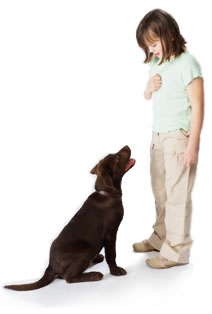Whenever a dog hears his feeding dish being handled, or his leash being taken from its place it knows what’s going to happen. So the Puppy is very early able to understand the connection food - cup, or walk – leash and anticipate the outcome. This is exactly what we are going to take advantage of.
The moment the Puppy sits down by himself we say “sit”. Repeatingly using the sit! command whenever the Puppy sits down will make your dog connect action and command. As with the cup and leash example the dog will sit down although the command is happening before the action taking place. Of course the Puppy will only sit down if not “disturbed” by something of major importance.
You may start to back your command after a few days of practice, by gently pushing your dog’s croup down with one hand and keeping his head up with the other. In doing so, we repeat the command "sit", "sit" with a comforting voice. Should the dog sit for about 5 seconds, this should be followed by exuberant praise and visible exaltation.
Your body language and voice must be a clear signal to your dog, that it has just achieved something world-shaking.
Do not start to train any other commands in that period, and don’t exercise the sit! command 5 times in a row! Let some time go by and don’t forget the celebration whenever it works out. Slowly increase the complicacy: Both of you are laying on the floor playing and out of the sky there comes the command.
Make sure to be consequent! Never repeat your command! Enforce the execution right after the first command! Support your verbal command with a precise hand signal. As soon as this works, try just calling the dog by its name and the use of the hand signal only the moment the dog is looking at you.
The next steps are to train the sit! command at close range. Use a light leash starting from about 1-2 yards and keep increasing the distance. At this point I suggest introducing your dog to a new kind of signal, the dog whistle, also known as silent whistle. There might come situations in your dog’s life, where your verbal commands might not be heard because of excessive noise or simply the distance. The dog whistle is the perfect tool in those situations as it has a long distance effect.
Choose a unique signal for this command and start using it in exchange to your verbal command. Make sure that this signal is clearly distinguishable for your dog from all other signals you plan to use for further commands.
0 comments
Post a Comment